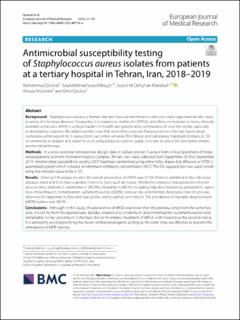| dc.description.abstract | Background
Staphylococcus aureus, a human skin and mucous membranes colonizer, could opportunistically cause a variety of infectious diseases. Frequently, it is resistant to methicillin (MRSA), and often, co-resistant to many clinically available antibiotics. MRSA is a major burden for healthcare systems and communities all over the world, especially in developing countries. We addressed the issue that more than a decade had passed since the last report about cumulative antibiogram for S. aureus from our center, whereas The Clinical and Laboratory Standards Institute (CLSI) recommends to analyze and report it on an annual basis in order to guide clinicians to select the best initial empiric antimicrobial therapy.
Methods
In a cross-sectional retrospective design, data of culture-proven S. aureus from clinical specimens of hospitalized patients at Imam Khomeini Hospital Complex, Tehran, Iran, were collected from September 2018 to September 2019. Antimicrobial susceptibility testing (AST) had been performed using either Kirby–Bauer disk diffusion or VITEK 2 automated system which is based on minimum inhibitory concentration (MIC). The Chi-squared test was used considering the critical p-value to be ≤ .05.
Results
Among 576 unique isolates, the overall prevalence of MRSA was 37.5%. Patients admitted to the infectious diseases ward and ICUs have a greater chance to have such an isolate. Methicillin resistance was predictive of resistance to most antibiotics: erythromycin (90.9%), clindamycin (85.4% including inducible resistance), gentamicin, cipro-/levo-/moxi-floxacin, trimethoprim–sulfamethoxazole (58.3%), tetracycline, and rifampin. Resistance rate of zero was observed for daptomycin, linezolid, tigecycline, and (roughly) vancomycin. The prevalence of multiple-drug resistant (MDR) isolates was 48.5%.
Conclusions
Although in this study, the prevalence of MRSA was lower than the previous ones from the same hospital, it is still far from the desired rates. Besides, resistance to clindamycin and trimethoprim–sulfamethoxazole were remarkable. So far, vancomycin is the best choice for empiric treatment of MRSA, with linezolid as the second choice. It is advised to avoid prescribing the newer antibacterial agents as long as the older ones are effective to prevent the emergence of MDR species. | en_US |

